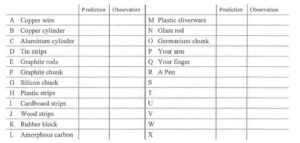Magnetic Exploration Part 3: Magnetic Personalities
Subject: Physics
Grade Level(s): Grade 4
Topic: Magnetism
Big Idea(s):
- Students know that magnets have two poles (north and south) and that like poles repel each other while unlike poles attract each other.
- Students know how to build a simple compass and use it to detect magnetic effects, including Earth’s magnetic field.
- Differentiate observation from inference (interpretation) and know scientists’ explanations come partly from what they observe and partly from how they interpret their observations.
- Formulate and justify predictions based on cause-and-effect relationships.
- Conduct multiple trials to test a prediction and draw conclusions about the relationships between predictions and results.
- Follow a set of written instructions for a scientific investigation.
What you need:
- Magnet kit
- Washers of various sizes
- Conductivity meter
- Paper clips
- Material kit
Grouping:
Vocabulary Words:
Time Needed:
Summary:
Magnetic Personalities; is a guided inquiry activity where you explore interactions
of different materials with magnets, to see what is attracted to a magnet and what is
not.
Learning Goals / Objectives:
1.) Students will gain a hands on understanding of many properties of permanent magnets. In particular they will learn
- About magnetic poles and their interactions with each other
- How to visualize and measure magnetic fields
- What materials are magnetic and what materials are not magnetic
- How to characterize the field strength of a permanent magnet
Background
Anticipatory Set:
Driving Questions
1.) How do magnets work?
2.) How does a compass work?
3.) How can we “see” magnetic fields?
Instructions / Activities:
In this activity you explore interactions of different materials with one of your strong magnets to see:
- What is attracted to a magnet?
- What is not?
- What happens to things that are attracted to a magnet, when they are in contact with a magnet?
Make sure you have access to the following:
• Washers of various sizes
• Conductivity meter
• Compass
• Paper clips
• Material kit: (may include some or all items in the table below)

1.) Use a strong magnet to test which materials are attracted to a magnet. Record your observations in your notebook.
2.) Pick a few test materials; some that are attracted to a magnet and some that are not.
3.) Bring the test material and the magnet together.
- Does the test material become magnetic while it is in contact with the magnet? (see what it does to a compass or try to pick up some paperclips.)
- Does the test material stay magnetic after it has been contact with the magnet?
Quick follow up questions:
1.) What trends did you see?
2.) What anomalies did you see?
3.) From your observations, can you make any general rules for determining what is magnetic and what is not?
Optional Further Consideration:
After finishing this activity, a student made the following observation and deduction: “The materials attracted to a magnet are metals and metals are all conductors. So, any material that is a good conductor should also be attracted to a magnet. “Compare your observations from “Conductivity Detectives Scavenger Hunt” to assess this hypothesis.
Assessment:
Teacher’s Discretion
Wrap-up / Closure:
Teacher’s Discretion

